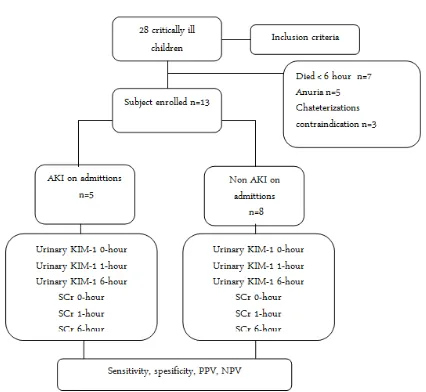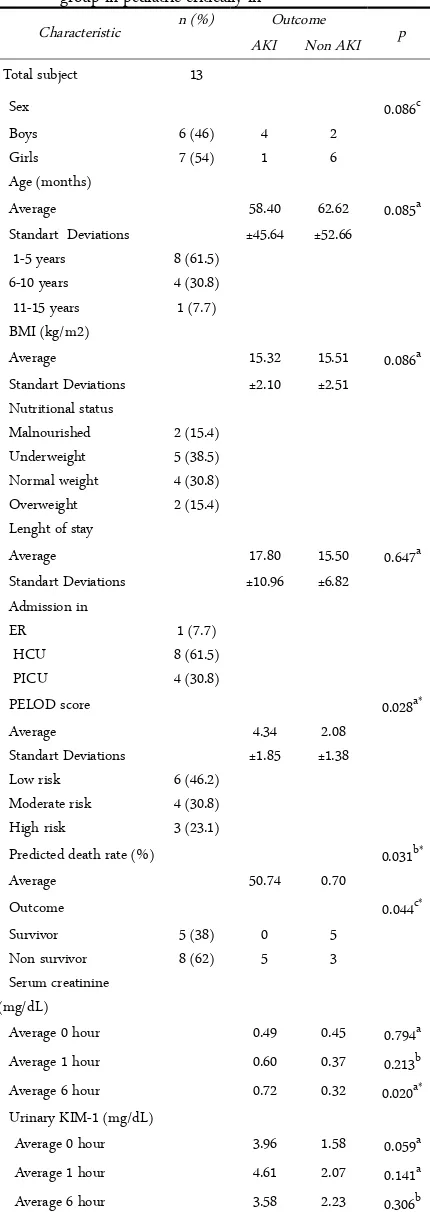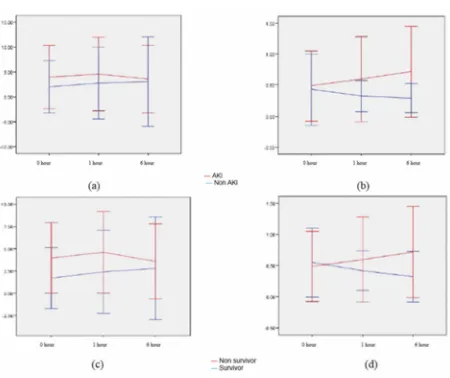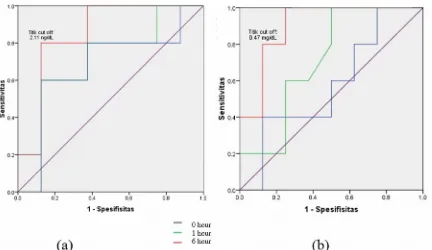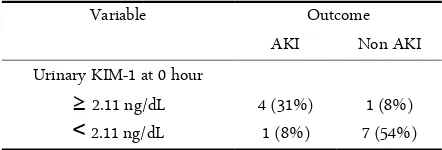Urinary Kidney Injury Molecule-1 (KIM-1) in Early Diagnosis of Acute Kidney Injury in Pediatric
Critically III
Irma Lestari Paramastuty1,3*
, Krisni Soebandiyah2,3
, Basuki B. Purnomo2,3
1Department of Child Health, Faculty of Medicine, Brawijaya University, Malang, Indonesia
2Department of Urology, Faculty of Medicine, Brawijaya University, Malang, Indonesia
3
dr. Saiful Anwar Public Hospital, Malang, Indonesia
ABSTRACT
Acute kidney injury (AKI) often associated with a high hospital morbimortality rate in the intensive care unit pa -tients. Kidney injury molecule-1 (KIM-1), has many characteristics of ideal biomarker for kidney injury. The aim of this study was to compared the temporal pattern of elevation urinary KIM-1 level following critically ill children with SCr as standart biomarker of AKI. Prospective analytic observational study was conducted during October to March 2014 in the Saiful Anwar General Hospital and Physiology Laboratory Brawijaya University. There were 13 critically ill as subjects. SCr and KIM-1 levels from all subjects were measured three times (at admission, after 1st and 6th hour). Subjects were devided into AKI - non-AKI groups by SCr level and survivor – non survivor group at the and of the observations. Results showed that there were significantly increased levels of KIM-1 in the AKI and non-AKI and survivor-non survivor group at time point. However, we found that delta KIM-1 at time point increased significant in non AKI group and survivor group. KIM-1 at admission can diagnosed AKI in critically ill children. We conclude that urinary KIM-1 is a sensitive non-invasive biomarker to diagnosed acute kidney injury in critically ill children. Increase level of KIM1 by time shows protective and good outcome in critically ill chil -dren.
Keyword: AKI, Critically ill, children, non-invasive biomarker urinary KIM-1 level
Acute kidney injury (AKI) is characterized by a sudden and generally reversible renal function impair-ment, involving inability to maintain the homeostasis, and may or not be accompanied by reduced diuresis. During the childhood, the etiology of AKI are sepsis, nephrotoxic drugs, and renal ischemia in criti¬cally ill patients, particularly those staying in in¬tensive care units (ICUs), are exposed to a number of conditions which may result in renal impairment, thus signifi-cantly increasing 40-90% the morbi-mortality rate. Hy-povolemia leading to hypoperfusion and consequent hypoxia; inflammatory and thrombotic events caused by sepsis; systemic inflammation from trauma, major surgeries, drugs interfering with the renal hemodynam-ics. Sepsis, and specially the septic shock, is one of the
main causes of AKI ntil now there were no data show pediatric AKI incidence in Indonesia. In Sanglah Hos-pital, Denpasar the incidence of pediatric AKI in pedi-atric intensive care unit (PICU) is 16.77% [2], while in PICU Wahidin Sudirohusodo Hospital, Makasar 80.05% critically ill patients had elevated of serum cre-atinine (SCr) level [3]. In 2012, the incidence of AKI in pediatric ward Saiful Anwar General Hospital is 4 cases per year and 1 cases per year in PICU [4]. At 3 to 5-year follow-up, 40% to 50% of pediatric patients who had AKI show signs of chronic renal insufficiency, in-dicating that sublethal injury permanently alters the re-nal bed [5].
Serum creatinin (SCr) concentration is the surro-gate test used to diagnose AKI but inadequate gold standard for several reasons. SCr has poor specificity in the settings of prerenal azotemia, changes in dietary in-take, and drug-induced changes in tubular secretion of creatinine, all of which may lead to change in SCr without actual injury to the kidney, poor sensitivity in the setting of adequate renal reserve,when SCr may not
JTLS | J. Trop. Life. Science 28 Volume 6 | Number 1 | January | 2016
INTRODUCTION
*Corresponding author: Irma Lestari Paramastuty
Figure 1. Flowchart of research subjects
change despite acute tubular injury because of compen-satory increases in function by other nephrons.The use of SCr may also lead to delays in diagnosis because of the relatively slow kinetics of the rise in SCr after in-jury [6].
KIM-1 (also known as TIM-1—T-cell immunoglob-ulin and mucin-containing molecule) is a type I cell membrane glycoprotein containing in its extracellular portion a 6-cysteine immunoglobulin-like domain and a Thr/Ser-Pro rich domain characteristic of mucinlike Oglycosylated proteins. The KIM-1 gene or protein ex-pression is undetectable in normal kidney, present in damaged tubular epithelial cells undergoing dedifferen-tiation and replication, persist until the damaged cells have completely recovered.
KIM-1 was a phosphatidylserine receptor that con-ferred on epithelial cells the properties of highly phagocytic cells, was able to specifically bind phos-phatidylserine on the apoptotic cell surface and trans-form tubular epithelial cells into semiprofessional phagocytes, which enhanced the clearance of apoptotic and necrotic cell debris. Functionally, the ability of KIM-1 to phagocytose apoptotic and necrotic cells in the tubule of the kidney may be critical for remodeling after injury to cleared of dead cell debris to relieve in-tratubular obstruction. KIM-1 may play an important role in limiting the autoimmune response to injury be-cause phagocytosis of apoptotic cells mediated by KIM-1 may result in the generation of antiinflammatory cy-tokines and restrain the activation of proinflammatory cytokines [7].
Research on urinary KIM-1 in animals and humans has been done but has not been done before in criti-cally ill children in Indonesia. The purpose of this
study is to compare the level of urinary KIM-1 with SCr as conventional AKI biomarker at time point in critically ill children.
Study design and subject
The current prospective observational analytic study was used in critically ill children who was stay in PICU/HCU/ER Saiful Anwar General Hospital, be-tween October 2013 and March 2014. A total of 15 out of 28 critically ill children whose parents signed written informed consent was selected as subjects. This study protocol was approved by research ethical clearance, is-sued by Health Research Ethics Commision, dr Saiful Anwar General Hospital, Malang Indonesia. The out-come was devided into 2 groups, AKI and non-AKI group on baseline examination then the changes of uri-nary KIM-1 and serum creatinine level was measured at the times point of admittions, 1 hour and 6 hour hospitalization.
Inclusions criteria
Critically ill children, aged 1-18 years, treated in the PICU/ ICU/ER, PaO2/FiO2 < 300 mmHg or use me-chanical ventilation, hemodynamic instability or re-quiring resuscitation or inotropic drugs, the parents willing to signed written informed consent to follow this research. Dropped out criteria are critically ill chil-dren whose met the inclusion criteria, died before 6 hour of admittions, or oligury during the time point of observations, or catheterization contraindication.
Exclusions criteria
Children with renal insufficiency (nephrotic syn-drome, nephritic syndrome), patients who received hemodyalisis, congenital kidney disease, autoimmune disease related to kidney, renal malignancy.
Operational definitions
Acute kidney injury (AKI) is sudden and generally reversible renal function impairment, involving inabil-ity to maintain the homeostasis, and may or not be ac-companied by reduced diuresis. AKI criteria in pedi-atric standardized using pedipedi-atric risk injury failure loss endstage (pRIFLE). Stage risk is characterized by re-duction in estimated creatinine clearance (eCCl) ≥
25% or a decrease in urine output 0.5 mL/kg/ h in 8 hours, stage injury is a reduction in estimated creati-nine clearance (eCCl) ≥ 50% or a decrease in urine output 0.5 mL/kg/h in 16 hours, stage failure is a re-duction in estimated creatinine clearance (eCCl) ≥
75% or a decrease in urine output 0.3 mL/kg/ h in 24 hours or anuria within 12 hours.Children with high risk AKI is critically ill children who are treated in an intensive care unit (PICU/HCU) or ER who had expe-rienced hypoxia, shock, sepsis, trauma, major surgery, use of sedatives, vasopressors, radiological contrast nephrotoxic drugs that interfere with renal hemody-namics. Critical illness was defined as a disturbance of homeostasis that requires treatment in an intensive care unit or require mechanical ventilation or PaO2/FiO2 < 300 mmHg, requiring intravenous in-otropic drugs or intravenous vasoconstrictive agents. Disease severity defined by a score of pediatric logistic organ dysfunction (PELOD score), patient stratification scale is divided into 3 scale, low scale (<10 points), medium scale (10-19 points), and high scale (>20 points) with the highest point is 71.
Processing and storage of urinary samples
Urinary collections was taken with aseptic method through the catheter in conjuction with serum sampling at three time point (on admittion, 1-hour, and 6-hour of admittions). Urinary samples then centrifuged to seperate the particles of urine and stored at -20ºC. Avoid the repeated freezing and thawing cycles.
Measurement of serum creatinine (SCr) level
Serum creatinine level was measured at the Laboratory of Pathology Clinic, Saiful Anwar General Hospital using enzymatic methode, Cobaz 6000.
Measurement of urinary KIM-1 level
Measurement of levels of urinary KIM-1 was conducted at the Laboratory of Physiology UB using the Human TIM-1/KIM-1 / HAVCR immunoassay for the quantitative determination of human T-cell immunoglobulin mucin (TIM-1) concentrations in urine, made by Quantikine ELISA (R & D system), catalog number DKM-100. This assay employs the quantitative sandwich enzymeimmunoassay technique. A monoclonal antibody specific for TM-1 has been precoated onto a microplate. Standarts and samples are pipetted into the wells and any TIM-1 present is bound by the immobilized antibody. After washing away any unbound substances, an enzyme-linked polyclonal antibody specific for TIM-1 is added to the wells. Following a wash to remove any unbound antibody-enzyme reagent, a substrate solution is added to the wells and color development is stopped and the intensity of the color is measured.
Table 1. Characteristics of subjects based on AKI and non AKI group in pediatric critically ill
Predicted death rate (%) 0.031b*
Average 50.74 0.70
Average 0 hour 0.49 0.45 0.794a Average 1 hour 0.60 0.37 0.213b Average 6 hour 0.72 0.32 0.020a* Urinary KIM-1 (mg/dL)
Average 0 hour 3.96 1.58 0.059a Average 1 hour 4.61 2.07 0.141a Average 6 hour 3.58 2.23 0.306b a) Independent t-test; b) Mann-Whitney test; c) Chi-square; *) Significant p<0.05
Statistical analysis
The differences KIM-1 level and serum creatinine at time point between AKI and non AKI group or sur-vivor and non sursur-vivor were analyzed using indepen-dent t-test, then analyzed receiver operating character-istic (ROC) was performed to predict the presence of early AKI in critically ill children. The statistic analysis used a statistical package for the social sciences (SPSS 15.0) for Windows.
Table 1 shows subjects’s characteristics based on gender, age, BMI, lenght of stay, the mean of serum creatinine levels and urinary KIM-1 level between AKI and nonAKI group. Only PELOD scores, predicted death rate, outcome show significant (p <0.05). Lenght of stay of AKI group in pediatric critically ill is 17 days
while nonAKI is 15 days. Score PELOD is one of MODS score in pediatric critically child that associated with increased mortality.8 Research conducted by Le-teurtre et al. (2010) state that the first day of PELOD scores associated with significant prognostic factor (odds ratio 1.16 that increase in every point, 95% CI) and the score 10-20 PELOD increase mortality of pedi-atric critically ill patients in the PICU.9
Refer to Figure 2A. found no significant difference in the urinary KIM – 1 level and between AKI and non AKI groups at time point (independent t-test p> 0.05), at admission, 1 hour and 6 hour respectively p=0.059, p=0.141, 0=0.306. Using pairwaise comparison to measured delta urinary KIM-1 level between time point we found significan between 0 to 1 hour (p=0.011).
RESULTS AND DISCUSSION
Table 2. Area under curve ROC urinary KIM-1 and serum creatinine
Variable Area Under Curve (95% CI) p KIM-1 0 hour 0.850 (95% CI=0.630 to 1.070) 0.040* KIM-1 1 hour 0.700 (95% CI=0.392 to 1.008) 0.242 KIM-1 6 hour 0.675 (95% CI=0.345 to 1.005) 0.306 Serum creatinine 0
hour
0.575 (95% CI=0.246 to 0.904) 0.661
Serum creatinine 1 hour
0.712 (95% CI=0.426 to 0.999) 0.213
Serum creatinine 6 hour
0.900 (95% CI=0.727 to 1.073) 0.019*
*) p< 0.05 significant
Refer to Figure 2C at the 0 hour or the initial ob-servation there were no difference between urinary KIM-1 levels in survivor and non survivor as well as 1 and 6 hour admission (Mann-Whitney U test respec-tively p=0.057, p=0.188, and p=0.242). Using Wilcoxon test (post hoc Friedman) we found significantly in-creased delta urinary KIM-1 level between 0-1 hour and 0-6 hour in survivor group respectively p=0.043 and p=0.043.
Refer to Figure 2B serum creatinine levels mea-sured at the 0, 1, and 6 hour after admissions. There were no significant different between 0 and 1 hour ad-mission between AKI and non AKI group but at 6 hour it show significant different (independent t-test p=0.020) while Figure 2D showed that there were no significant different serum creatinin level between sur-vivor and non sursur-vivor at time point (independent t-test respectively p=0.347, p=0.608, and p=0.178).
Kidney injury molecule- 1 (KIM-1) is a transmem-brane protein in humans that are not detected in urine of subject’s normal kidney tissue in normal conditions but expressed in very high levels in proximal tubular epithelial cells undergo dedifferentiation [10]. In this study urinary KIM-1 level found no significant differ-ence at time point between AKI and non AKI groups. This study is similar to research conducted by Bogh-dady et al. (2013) in adult critically ill patients that the levels of urinary KIM-1 level at admissions the ICU did not differ significantly in AKI and non AKI group but that study found significant differences in the 6 – 12 hour of admissions [11]. Other research states that the expression of KIM-1 is slower than the urine NGAL in patients after cardiac surgery. This can be ex-plained by the presence of subclinical injury that oc-curred outside of the renal proximal tubule or even se-vere damage of proximal tubular epithelial cells
becau-Figure 3. Urinary KIM-1 (a) and serum creatinine ROC (b)
se of KIM-1 is a transmembrane glycoprotein is con-fined only to the surviving proximal tubular epithelial cells after the injury [12].
In this study found no significant difference in the levels of urinary KIM-1 between survivor and non sur-vivor in time point but it was found a significant differ-ence in the levels of urinary KIM-1 0-1 hours and 0-6 hours admissions in survivor. The trends tendency found that the levels of urinary KIM-1 non survivor is higher than survivor. Research conducted by Han et al.. (2002) stated that urinary KIM-1 was significantly increased in patients ischemic ATN 12 hours after is-chemic injury [13]. High urinary KIM-1 expression is associated with poor clinical outcome in AKI patients [11, 14]. Research conducted by Van Timmeren et al. (2007) stated that the levels of urinary KIM-1 related to the degree of renal tubular damage histopathology [15]. While the tendency found that the levels of sur-vivor urinary KIM-1 continues to increase until hours to 6 treatments. Research conducted by Ichimura et al.. (2008) stated that the KIM-1 mediates clearance of apoptotic and necrotic debris in the tubular lumen and triggers apoptosis mediated internalization when bind-ing to the cell surface. Phagocytosis of apoptotic cells led to an increase of anti-inflammatory cytokines that resist the activation of proinflammatory cytokines, as well as hepatocyte growth factor (HGF), known as re-nal repair factor, increased in epithelial cells phagocy-tize apoptotic cells [16]. Urinary KIM-1 increased along with the increase in bromodeoxyuridine (prolif-eration marker) and elastin (dedifferentiation marker) so that the KIM-1 plays a role in the regeneration of tubular epithelial cells [7]. So that researchers can only speculate that urinary KIM-1 has a detrimental effect in a harmful and protective mechanism [15]. Increased levels of urinary KIM-1 related to the degree of renal tubular damage associated with death, but on the other side of the KIM-1 urinalysis provide a protective effect by inducing apoptosis and anti-inflammatory
tokines.
In this study there were significant differences in serum creatinine levels between patients between AKI and non AKI group at 6 hour admissons. However, there no significant differences at time point between survivor and non survivor. In other hand the tendency of serum creatinine levels in non survivor increased at time point while decreased in survivor. Research con-ducted by Newsome et al. (2008) suggest that small changes in serum creatinine levels during treatment in-creases the risk of terminal renal failure and death.17 Increased of serum creatinine 0.3 mg/dL or more asso-ciated with poor clinical outcome.18 A similar study is showed by Nin et al. (2009) who examined the serum creatinine levels in patients undergo mechanical venti-lation that small changes of serum creatinine in the ad-missions while many clinicians do not react with changes of 0.3 mg/dL were associated with poor out-come. From this study it was found that delta serum creatinine of more than 0.31 mg/dL increase of 1.37 times the risk of death in patients with mechanical ventilation (95 % CI) [19].
Table 2 shows that AUC of urinary KIM-1 at ad-mission 0.850 (> 0.7) with a p value of 0.040, so it can be used to predict the AKI in pediatric critically ill. Meanwhile, the levels of KIM-1 AUC at 1 hour and 6 hour is 0.700 (p = 0.242) and 0.675 (p = 0.306) so it can not be used as a predictive AKI. The AUC of crea-tinine levels at 6 hour is 0.900 (> 0.7) with p = 0.019, which means creatinine levels to-6 hours can be used as a predictor AKI.
Figure 3A shows the ROC curve levels of KIM-1 hour 0 is 0.850 (95% CI = 0.630 to 1.070), p = 0.040. Based on the ROC curve can be determined cut-off value for AKI classification. ROC curve analysis of the urine levels of KIM-1 0 hour is 2.11 ng/dL (Table 3). AUC of creatinine 6 hour (red line on Figure 3b) is 0.900 (95 % CI = 0.727 to 1.073) p = 0.019. From the ROC curve analysis of 6 hour creatinine levels, note that the cut-off point for predicting creatinine levels AKI output is 0.465 mg/dL.
Table 3. Cut off of urinary KIM-1 at admission
Variable Outcome
AKI Non AKI
Urinary KIM-1 at 0 hour 2.11 ng/dL
≥ 4 (31%) 1 (8%)
2.11 ng/dL
˂ 1 (8%) 7 (54%)
This is in line with research by Prozialeck et al.
(2009) which states that the increased of urinary KIM-1 earlier than the increase in serum creatinine [20]. Re-search conducted by Han et al. (2002) in critically ill adult patients showed that the ranges of urinary KIM-1 levels were 1.34 ng/dL to 2.99 ng/dL [13]. In a study conducted by Han et al. (2008) in patients whose done cardio pulmonary baypass found increased of urinary KIM-1 level at 6-12 hours after surgery and urinary KIM-1 AUC at 2 hour admissions was 0.57, while 12 and 24 hour was respectively 0.83 and 0.78 [21]. Re-search conducted by Liangos et al. (2009) states that between 6 urinary biomarkers studied in cardiac surgery patients, urinary KIM-1 has a good perfor-mance to predict AKI 2 hours after surgery with AUC 0.78 [22].
There are several limitation of the current result. The subject follow the study is relative small so the fu-ture study need a large number of pediatric critically ill in multicenter research. The increased levels of urinary KIM-1 significantly at 6-12 hours after renal injury need longer examination of serial urinary levels of KIM-1.
Figure 4. Urinary KIM-1 and serum creatinine level at time point
Our study state that urinary KIM-1 is a sensitive non-invasive biomarker to diagnose AKI in critically ill children. Increase level of KIM-1 by time shows AKI protective and good outcome. Urinary KIM-1 has good sensitivity and spesifisity to early diagnose AKI in critically ill children.
The author thanks to technician in Laboratory of Physiology Faculty of Medicine University of Brawijaya, Malang Indonesia (Mr. Satuman) for his good assistance.
1. KMS Freire, NL Bresolin, ACF Farah, FLC Carvahlo, JEC Goes (2010) Acute kidney injury in children: incidence and prognostic factors in critically ill patients. Rev. Bras. Ter. Intensiva. 22(2):166-174
2. GAP Nilawati (2012) Kejadian acute kidney injury dengan kriteria pRIFLE pada unit perawatan intensif anak rumah sakit Sanglah Denspasar. Sari Pediatri. 14(3): 158-161 3. H Albar (2013) Acute kidney injury in critically ill
children at pediatric intensive care unit. CDK-211. 40(12): 890-893
4. Cahyono HA (2012) Laporan tahunan ruang rawat inap IV. In: RSSA I.K.A (ed). Malang: Instalasi rawat inap IV 5. RK Basu, P Devarajan, H Wong, SD Wheeler (2011) An
update and review of acute kidney injury in pediatrics. Pediatr. Crit. Care. Med. 12(3):339-347
6. SS Waikar, RA Betensky, SC Emerson, JV Bonventre (2012) Imperfect gold standart for kidney injury biomarker evaluation. J. Am. Nephrol. 23:13-21 7. W Huo, K Zhang, Z Nie, Q Li, F Jin (2010) Kidney
injury molecule-1 (KIM-1): a novel kidney- specific injury molecule playing potential double-edged functions in kidney injury. Transplatation Reviews. 24: 143-146 8. J Lacroix, J Cotting (2005) Severity of illness and organ
dysfunction scoring in children. Pediatr. Crit. Care. Med. 6:S126-S134
9. S Leteurtre, A Duhamel, B Grandbastien, F Proulx, J Cotting, R Gottesman, A Joffe, B Wagner, P Hubert, A Martinot, J Lacroix, F Leclerc.(2010.) Daily estimation of the severity of multiple organ dysfunction syndrome in critically ill children. CMAJ. 182(11):1181-1187
10. Z Zhang, BD Humphreys, JV Bonventre (2007) Shedding of the urinary biomarker kidney injury molecule-1 (KIM-1) is regulated by MAP kinases and juxtamembrane region. J. Am. Soc. Nephrol. 18:2704–2714
11. IMB Boghdady, MMEL Naggar, MM Emara, RM El-shazly, KS Mahmoud (2013) Kdney injury molecule-1 as an early marker for acute kidney injury in critically ill patients. Menoufia Medical Journal. 26: 98-104
12. HRH De Geus, G Fortrie, MGH Betjes, RHN van Schaik. ABJ Groenevelt (2013) Time of injury affects urinary biomarker predictive values for acute kidney injury in critically ill, non-septic patients. BMC Nephrology.14: 273 13. WK Han, V Bailly, R Abichandani, R Thadani, JV
Bonventre (2002) Kidney injury molecule-1 (KIM-1): a novel biomarker for human renal proximal tubule injury. Kidney Int. 62: 237-244
14. O Liangos, MC Perianayagam, VS Vaidya, WK Han, R Wald, H Tighiouart, RW MacKinnon, L Li, VS Balakrishnan, BJG Pereira, JV Bonventre, BL Jaber (2007) Urinary N-Acetyl-β-(D)-Glucosaminidase activity and kidney injury molecule-1 level are associated with adverse outcomes in acute renal failure. J. Am. Soc. Nephrol. 18: 904–912
15. MM Van Timmeren, MC Van Den Heuvel, V Bailly, SJ Bakker, H Van Goor, CA Stageman, (2007) Tubular kidney injury molecule-1 (KIM-1) in human renal disease. J. Pathol. 212: 209–211
16. T Ichimura, EJ Asseldonk, BD Humphreys, L Gunaratman, JS Duffield, JV Bonventre (2008) Kidney injury molecule-1 is a phosphatidylserine receptor that confers a phagocytic phenotype on epithelial cells. J. Clin. Invest. 118: 1657–1668
17. BB Newsome, DG Warnock, WM McClellan, CA Herzog, CI Kiefe, PW Eggers (2008) Long-term risk of mortality and end-stage renal disease among the elderly after small increases in serum creatinine level during hospitalization for acute myocardial infarction. Arc. Intern. Med. 168(6): 609-616
18. RL Mehta, J Kellum, S Shah S (2007) Acute Kidney Injury Network: report of an initiative to improve outcomes in acute kidney injury. Crit. Care.11(2): R31
19. N Nin, R Lombardi, F Fritos-Vivar, A Esterban, JA Lorente, ND Ferguson (2010) Early and small changes in serum creatinine concentrations are associated with mortality in mechanically ventilated patients. Shock. 34(2):109-116
20. WC Prozialeck, JR Edwardsa, PC Lamara, J Liub, VS Vaidya, JV Bonventre (2009). Expression of kidney injury molecule-1 (Kim-1) in relation to necrosis and apoptosis during the early stages of Cd-induced proximal tubule injury. Toxicol. Appl. Pharmacol. 238(3):306-314 21. WK Han, SS Waikar, A Johnson A (2008) Urinary
biomarkers in the early diagnosis of acute kidney injury. Kidney international. 73: 863-869
22. O Liangos, A Kolyada, H Tighiouart, MC Perianayagam, R Wald, BL Jaber (2009) Interleukin-8 and acute kidney injury following cardiopulmonary bypass: a prospective cohort study. Nephron. Clin. Pract. 113(3): c148-c154.
JTLS | J. Trop. Life. Science 29 Volume 6 | Number 1 | January | 2016
REFERENCES
